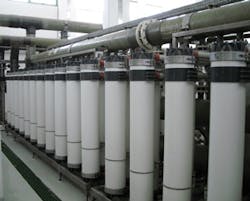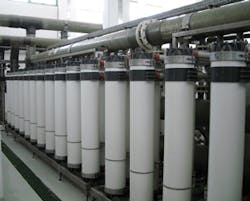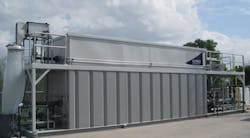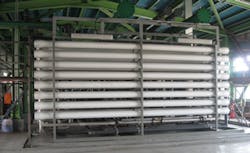Reuse, expanded treatment drive interest in membrane systems
by James Laughlin, Industrial Waterworld Editor
The industrial/commercial water market is showing a growing interest in the use of membrane treatment systems both for treating water coming into their facilities and wastewater prior to discharge. Interest in the technology is being driven by a growing demand for water reuse, the ability to expand treatment in a small footprint, and the ease of operation for automated systems.
Typical membrane systems include microfiltration, ultrafiltration, nanofiltration, and reverse osmosis. Industries where membrane use is expanding include mining, semiconductor, pulp & paper, food & beverage, and pharmaceuticals, among others.
"There's some really exciting stuff taking off right now in the oil and gas industry dealing with produced waters," said Robert McCandless, P.E., Brown and Caldwell. "Some of the more cutting edge things are being done there because of the variety of waste streams and the challenges of treating them."
In many industries, water uses can be categorized as primary and secondary. Primary categories include water that comes into direct contact with a manufactured product or is used as an ingredient. Secondary uses include cooling, boiler feed, general cleaning, washdown, and landscape irrigation.
While the technology exists to treat reclaimed water to the standards required for primary uses, most industries are not willing to take that step. In fact, many industries take extensive steps to treat their incoming process water, no matter what the source, said Anthony Wachinski, Senior Vice President and Technical Director at Pall Water Processing.
"Many industries are starting to use membranes to treat their process water to meet their requirements. The chief technology there is microfiltration or ultrafiltration," Wachinski said. "For groundwater, you use microfiltration with a little bit of chemistry to remove things like iron, manganese and arsenic. If it's a surface water, you are removing solids to get it to be fairly clean; with NTUs, it's usually less than 0.1."
Some industries take it a step further and add nanofiltration or reverse osmosis to further treat the water to ultrapure standards, he said.
To view the inset portion of this article, please click here.
On the wastewater side of the equation, there is growing interest in membrane systems for a variety of reasons, foremost being the ability to recycle the water instead of discharging.
"It can cost you from $2 to $10 per thousand gallons to buy and treat water coming in," Wachinski said. "If you have already treated that water you can most likely treat it for less money and reuse your wastewater."
"Usually MF is the workhorse membrane. It can take most industrial waters with minimal pretreatment. Depending on the membrane and depending on the water, you may have to stick something in front of it to get it clean enough for the membrane," he said. "After microfiltration, that water is coming out with less than 0.1 NTU, so you may be able to reuse that water directly into various parts of your industry."
Membrane bioreactor systems have taken off in recent years. They offer a dramatic improvement in effluent quality and can help industrial/commercial facilities expand their treatment capacity without having to expand their treatment plant footprint.
"Inquiries for MBRs in industrial applications have really increased," said Dave Holland, Senior Application Engineer, Aqua-Aerobic Systems Inc. "Most of these applications have been pilots. We just conducted one at a chemical manufacturer. We've had several other inquiries that will become a reality in the next month or so."
MBRs are attractive because of their ability to handle high strength waste and variable loadings, which is particularly important for industry, McCandless said.
"A lot of industry operates on batch cycles. MBRs are well adapted to handling that, better than a lot of the conventional activated sludge processes," he said. "The other thing that is really good about them is their ability to deal with a lot of manmade compounds, pharmaceuticals, personal care products, and things like that. For a number of reasons, the long sludge ages help with degradation or adsorption of the compounds. Plus you get a very clear effluent, which can be reused in your process or as feedwater to RO."
Pulp & paper, breweries and pharmaceuticals are three industries that have been quick to adopt the technology, McCandless said.
The cost of water, growing concerns about water scarcity and the cost of discharging water to local sewers all play a role in driving interest in water reuse. Membrane systems are often the first choice when developing a water recycling program.
"The thing for industry is to keep the water inside the plant and not have to buy new water. Keep reusing the water you have as much as you can. Avoid, if you can, discharging water mainly because of the permits," Wachinski said.
Disposal costs can be especially high for facilities with a high volume of liquid wastes, McCandless said.
"One of the projects I looked at was a brewery that wanted to expand, but they would have had to pay the city to increase the size of the sewer. By using an MBR, they were able to recycle a high percentage of the water, avoid the increase in the sewer charge and reuse all the water internally, and [they] recovered their money in something like two years," he said.
Secondary uses of water such as cooling, boiler feed, landscaping, and general rinsing and cleaning offer significant opportunities for reuse. Membrane technologies can even provide the appropriate level of treatment to meet the water quality requirements of low and high pressure boiler feed uses.
"If it's low pressure, basically you can get by with an MF and an RO and straight from the RO to a mixed-bed ion exchange," Wachinski said. "If you have a high pressure boiler, you usually have to add an EDI unit."
For many reuse applications, ultrafiltration is enough, McCandless said.
"At a lot of these facilities, ultrafiltration is such a big step up in water quality that it allows you to do a lot more reuse," McCandless said. "With ultrafiltration, there is a pretty low percentage of waste generation, and the water quality is very high so it's good for all kinds of things. You can use it in cooling towers, landscaping, maybe some lower grade rinsing, and cleaning operations."
Mobile & Packaged Solutions
For most industrial/commercial facilities, water treatment is a sideline to their actual business and often outside their area of expertise. Many managers want simple, packaged or mobile systems that can be implemented quickly with minimal disruption to operations and also minimal operator attention.
Packaged systems are typically pre-designed treatment systems based on pipe size and come in a package ready to assemble on site. Container systems are also available that can be shipped in and dropped in place ready to go. "Bad water goes in, and good water comes out," Wachinski said.
Trailer-mounted mobile systems are also seeing rapid growth. Often mounted on a 40-foot trailer, they can be parked next to a facility, hooked up and ready to go in a very short timeframe. They can also be moved or replaced as needs change.
"A lot of people in the industry don't want to deal with water treatment. That's where portable water treatment has grown," Wachinski said. "Bring in a trailer with MF or MF/RO and hook it up and start providing water."
Evolving Materials
The most common membrane materials are polyvinylidene difluoride (PVDF), polyethersulfone, polyethylene, polyvinyl chloride, and ceramic. There has been a general push in recent years toward the use of PVDF because of its chlorine resistance and improved flexibility. Polyethersulfone can't handle chlorine but can be cleaned with caustic, which can be attractive in applications where chlorine would be a problem.
Ceramic membranes are coming down in price but remain a niche product, Holland said. "It is still more of a niche in the industrial market depending on temperature and chemical constituents in the water."
The upside of ceramic membranes is the ability to survive where other membranes can't.
"Ceramics have very high capital costs, but if you don't drop it and break it, it can pretty much withstand anything, and you can use just about any chemical to clean it," Wachinski said.
A newer evolution in the membrane market is Forward Osmosis technology. While still in its infancy, it offers promise for the industrial market, McCandless said.
"At the membrane technology conference last year, there was a lot of buzz about Forward Osmosis as an application that shows a lot of promise because it's able to treat brine at a much higher concentration than reverse osmosis," he said. The systems can get "brine up into a category of what they call 10 pound brine. Basically it's 10 pounds per gallon and it's very useful for kill fluid in oil wells. It's highly sought after by the drillers."



